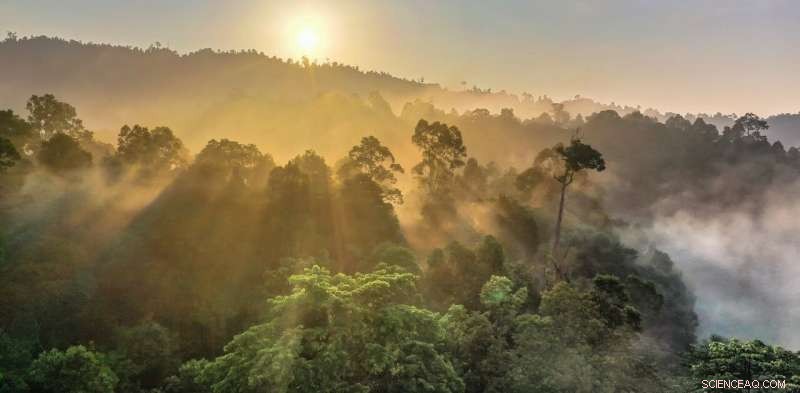
Une forêt tropicale humide en Amérique du Sud. Crédits :Shutterstock/BorneoRimbawan
Un matin de 2009, Je me suis assis dans un bus grinçant qui serpentait à flanc de montagne dans le centre du Costa Rica, étourdi par les vapeurs de diesel alors que je serrais mes nombreuses valises. Ils contenaient des milliers de tubes à essai et de flacons d'échantillons, une brosse à dent, un cahier étanche et deux vêtements de rechange.
J'étais en route pour la station biologique de La Selva, où je devais passer plusieurs mois à étudier le mouillé, réponse de la forêt tropicale de plaine aux sécheresses de plus en plus courantes. De part et d'autre de l'étroite route, les arbres saignaient dans la brume comme des aquarelles dans du papier, donnant l'impression d'une forêt vierge infinie baignée de nuages.
Alors que je regardais par la fenêtre le paysage imposant, Je me demandais comment je pouvais espérer comprendre un paysage si complexe. Je savais que des milliers de chercheurs à travers le monde étaient aux prises avec les mêmes questions, essayer de comprendre le sort des forêts tropicales dans un monde en évolution rapide.
Notre société demande tellement à ces écosystèmes fragiles, qui contrôlent la disponibilité de l'eau douce pour des millions de personnes et abritent les deux tiers de la biodiversité terrestre de la planète. Et de plus en plus, nous avons imposé une nouvelle demande à ces forêts :nous protéger du changement climatique causé par l'homme.
Les plantes absorbent le CO
Mais le fait est qu'il n'y a pas assez d'arbres pour compenser les émissions de carbone de la société – et il n'y en aura jamais. J'ai récemment effectué une revue de la littérature scientifique disponible pour évaluer la quantité de carbone que les forêts pourraient absorber. Si nous maximisions absolument la quantité de végétation que toute terre sur Terre pourrait contenir, nous séquestrerions suffisamment de carbone pour compenser environ dix ans d'émissions de gaz à effet de serre aux taux actuels. Après ça, il ne pourrait plus y avoir d'augmentation de la capture du carbone.
Pourtant, le sort de notre espèce est inextricablement lié à la survie des forêts et à la biodiversité qu'elles contiennent. En s'empressant de planter des millions d'arbres pour capturer le carbone, pourrions-nous endommager par inadvertance les propriétés mêmes des forêts qui les rendent si essentielles à notre bien-être ? Pour répondre à cette question, nous devons considérer non seulement comment les plantes absorbent le CO
Comment les plantes luttent contre le changement climatique
Les plantes convertissent le CO
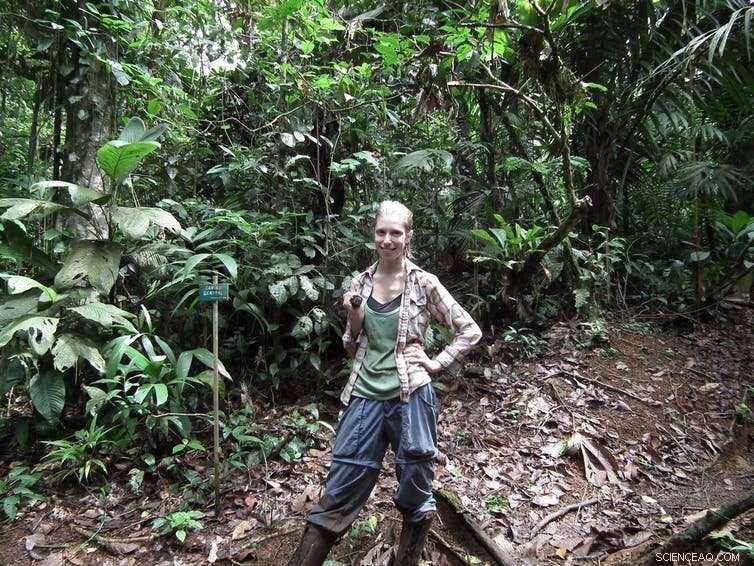
Bonnie Waring mène des recherches à la Station biologique de La Selva, Costa Rica, 2011. Auteur fourni
Bien que ce processus libère naturellement du CO
Parce que les plantes (en particulier les arbres) sont d'excellents réservoirs naturels de carbone, il est logique que l'augmentation de l'abondance des plantes à travers le monde puisse réduire le CO atmosphérique
Les plantes ont besoin de quatre ingrédients de base pour pousser :la lumière, CO
C'est une tâche étonnamment difficile, étant donné que les humains modifient simultanément tant d'aspects de l'environnement naturel en chauffant le globe, modifier les régimes de précipitations, couper de vastes étendues de forêt en minuscules fragments et introduire des espèces exotiques là où elles n'appartiennent pas. Il y en a aussi plus de 350, 000 espèces de plantes à fleurs sur terre et chacune répond aux défis environnementaux de manière unique.
En raison des manières compliquées dont les humains modifient la planète, il y a beaucoup de débats scientifiques sur la quantité précise de carbone que les plantes peuvent absorber de l'atmosphère. Mais les chercheurs sont unanimes sur le fait que les écosystèmes terrestres ont une capacité limitée à absorber le carbone.
Si nous veillons à ce que les arbres aient suffisamment d'eau à boire, les forêts deviendront hautes et luxuriantes, créant des auvents ombragés qui affament les petits arbres de lumière. Si on augmente la concentration de CO
Face à ces contraintes fondamentales, les scientifiques estiment que les écosystèmes terrestres peuvent contenir suffisamment de végétation supplémentaire pour absorber entre 40 et 100 gigatonnes de carbone de l'atmosphère. Une fois cette croissance supplémentaire réalisée (processus qui prendra plusieurs décennies), il n'y a pas de capacité de stockage supplémentaire de carbone sur terre.
Mais notre société verse actuellement du CO
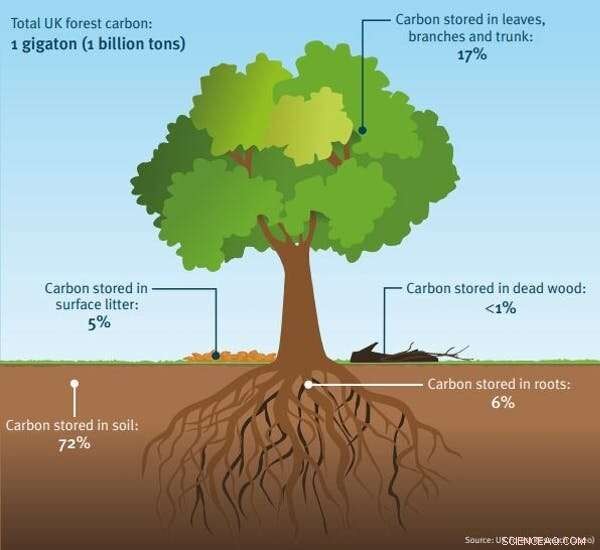
Feuille au microscope :la stomie qui régule l'oxygène et le dioxyde de carbone est visible. Crédits :Shutterstock/Barbol
Péril et promesse
Malgré toutes ces contraintes physiques bien connues sur la croissance des plantes, il y a un nombre croissant d'efforts à grande échelle pour augmenter la couverture végétale afin d'atténuer l'urgence climatique – une solution climatique dite « basée sur la nature ». La grande majorité de ces efforts se concentrent sur la protection ou l'expansion des forêts, car les arbres contiennent beaucoup plus de biomasse que les arbustes ou les graminées et représentent donc un potentiel de capture de carbone plus important.
Pourtant, des malentendus fondamentaux sur la capture du carbone par les écosystèmes terrestres peuvent avoir des conséquences dévastatrices, entraînant des pertes de biodiversité et une augmentation du CO
La réponse réside dans les complexités subtiles de la capture du carbone dans les écosystèmes naturels. Pour éviter les dommages environnementaux, nous devons nous abstenir d'établir des forêts là où elles n'appartiennent naturellement pas, éviter les « incitations perverses » à abattre la forêt existante afin de planter de nouveaux arbres, et considérez comment les semis plantés aujourd'hui pourraient se porter au cours des prochaines décennies.
Avant d'entreprendre toute expansion de l'habitat forestier, nous devons nous assurer que les arbres sont plantés au bon endroit car tous les écosystèmes terrestres ne peuvent ou ne doivent pas supporter les arbres. La plantation d'arbres dans des écosystèmes qui sont normalement dominés par d'autres types de végétation n'aboutit souvent pas à une séquestration du carbone à long terme.
Un exemple particulièrement illustratif vient des tourbières écossaises - de vastes étendues de terre où la végétation basse (principalement des mousses et des herbes) pousse dans des zones constamment détrempées, sol humide. Parce que la décomposition est très lente dans les sols acides et gorgés d'eau, les plantes mortes s'accumulent sur de très longues périodes de temps, créer de la tourbe. Il n'y a pas que la végétation qui est préservée :les tourbières momifient également ce qu'on appelle les « corps des tourbières », les restes presque intacts d'hommes et de femmes décédés il y a des millénaires. En réalité, Les tourbières britanniques contiennent 20 fois plus de carbone que les forêts du pays.
Mais à la fin du 20e siècle, certaines tourbières écossaises ont été asséchées pour la plantation d'arbres. Le séchage des sols a permis aux semis d'arbres de s'établir, mais a également provoqué l'accélération de la décomposition de la tourbe. L'écologiste Nina Friggens et ses collègues de l'Université d'Exeter ont estimé que la décomposition de la tourbe en train de sécher libérait plus de carbone que les arbres en croissance ne pouvaient en absorber. Clairement, les tourbières peuvent mieux protéger le climat lorsqu'elles sont laissées à elles-mêmes.
Il en est de même pour les prairies et les savanes, où les incendies font naturellement partie du paysage et brûlent souvent des arbres plantés là où ils n'appartiennent pas. Ce principe s'applique également aux toundras arctiques, où la végétation indigène est couverte de neige tout l'hiver, réfléchissant la lumière et la chaleur vers l'espace. Planter en hauteur, les arbres à feuilles sombres dans ces zones peuvent augmenter l'absorption d'énergie thermique, et entraîner un réchauffement local.
Mais même planter des arbres dans des habitats forestiers peut avoir des conséquences environnementales négatives. Du point de vue à la fois de la séquestration du carbone et de la biodiversité, all forests are not equal—naturally established forests contain more species of plants and animals than plantation forests. They often hold more carbon, trop. But policies aimed at promoting tree planting can unintentionally incentivise deforestation of well established natural habitats.

Where carbon is stored in a typical temperate forest in the UK. Credit:UK Forest Research, CC PAR
A recent high-profile example concerns the Mexican government's Sembrando Vida program, which provides direct payments to landowners for planting trees. The problem? Many rural landowners cut down well established older forest to plant seedlings. This decision, while quite sensible from an economic point of view, has resulted in the loss of tens of thousands of hectares of mature forest.
This example demonstrates the risks of a narrow focus on trees as carbon absorption machines. Many well meaning organizations seek to plant the trees which grow the fastest, as this theoretically means a higher rate of CO
Yet from a climate perspective, what matters is not how quickly a tree can grow, but how much carbon it contains at maturity, and how long that carbon resides in the ecosystem. As a forest ages, it reaches what ecologists call a "steady state"—this is when the amount of carbon absorbed by the trees each year is perfectly balanced by the CO
This phenomenon has led to an erroneous perception that old forests are not useful for climate mitigation because they are no longer growing rapidly and sequestering additional CO
What about situations where fast growing forests are cut down every few decades and replanted, with the extracted wood used for other climate-fighting purposes? While harvested wood can be a very good carbon store if it ends up in long lived products (like houses or other buildings), surprisingly little timber is used in this way.
De la même manière, burning wood as a source of biofuel may have a positive climate impact if this reduces total consumption of fossil fuels. But forests managed as biofuel plantations provide little in the way of protection for biodiversity and some research questions the benefits of biofuels for the climate in the first place.
Fertilize a whole forest
Scientific estimates of carbon capture in land ecosystems depend on how those systems respond to the mounting challenges they will face in the coming decades. All forests on Earth—even the most pristine—are vulnerable to warming, changes in rainfall, increasingly severe wildfires and pollutants that drift through the Earth's atmospheric currents.
Some of these pollutants, cependant, contain lots of nitrogen (plant fertilizer) which could potentially give the global forest a growth boost. By producing massive quantities of agricultural chemicals and burning fossil fuels, humans have massively increased the amount of "reactive" nitrogen available for plant use. Some of this nitrogen is dissolved in rainwater and reaches the forest floor, where it can stimulate tree growth in some areas.
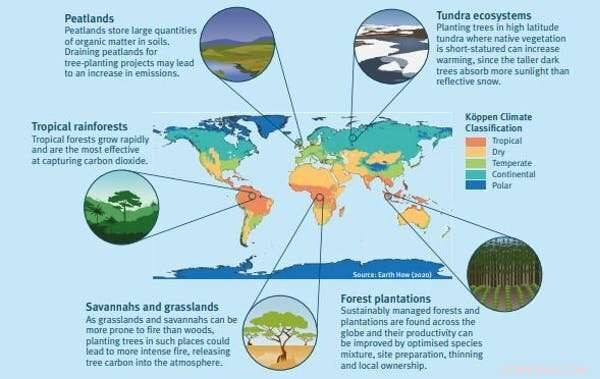
Implications of large-scale tree planting in various climatic zones and ecosystems. Credit:Stacey McCormack/Köppen climate classification, Auteur fourni
As a young researcher fresh out of graduate school, I wondered whether a type of under-studied ecosystem, known as seasonally dry tropical forest, might be particularly responsive to this effect. There was only one way to find out:I would need to fertilize a whole forest.
Working with my postdoctoral adviser, the ecologist Jennifer Powers, and expert botanist Daniel Pérez Avilez, I outlined an area of the forest about as big as two football fields and divided it into 16 plots, which were randomly assigned to different fertilizer treatments. For the next three years (2015-2017) the plots became among the most intensively studied forest fragments on Earth. We measured the growth of each individual tree trunk with specialised, hand-built instruments called dendrometers.
We used baskets to catch the dead leaves that fell from the trees and installed mesh bags in the ground to track the growth of roots, which were painstakingly washed free of soil and weighed. The most challenging aspect of the experiment was the application of the fertilizers themselves, which took place three times a year. Wearing raincoats and goggles to protect our skin against the caustic chemicals, we hauled back-mounted sprayers into the dense forest, ensuring the chemicals were evenly applied to the forest floor while we sweated under our rubber coats.
Malheureusement, our gear didn't provide any protection against angry wasps, whose nests were often concealed in overhanging branches. Mais, our efforts were worth it. After three years, we could calculate all the leaves, wood and roots produced in each plot and assess carbon captured over the study period. We found that most trees in the forest didn't benefit from the fertilizers—instead, growth was strongly tied to the amount of rainfall in a given year.
This suggests that nitrogen pollution won't boost tree growth in these forests as long as droughts continue to intensify. To make the same prediction for other forest types (wetter or drier, younger or older, warmer or cooler) such studies will need to be repeated, adding to the library of knowledge developed through similar experiments over the decades. Yet researchers are in a race against time. Experiments like this are slow, painstaking, sometimes backbreaking work and humans are changing the face of the planet faster than the scientific community can respond.
Humans need healthy forests
Supporting natural ecosystems is an important tool in the arsenal of strategies we will need to combat climate change. But land ecosystems will never be able to absorb the quantity of carbon released by fossil fuel burning. Rather than be lulled into false complacency by tree planting schemes, we need to cut off emissions at their source and search for additional strategies to remove the carbon that has already accumulated in the atmosphere.
Does this mean that current campaigns to protect and expand forest are a poor idea? Emphatically not. The protection and expansion of natural habitat, particularly forests, is absolutely vital to ensure the health of our planet. Forests in temperate and tropical zones contain eight out of every ten species on land, yet they are under increasing threat. Nearly half of our planet's habitable land is devoted to agriculture, and forest clearing for cropland or pasture is continuing apace.
Pendant ce temps, the atmospheric mayhem caused by climate change is intensifying wildfires, worsening droughts and systematically heating the planet, posing an escalating threat to forests and the wildlife they support. What does that mean for our species? Again and again, researchers have demonstrated strong links between biodiversity and so-called "ecosystem services"—the multitude of benefits the natural world provides to humanity.
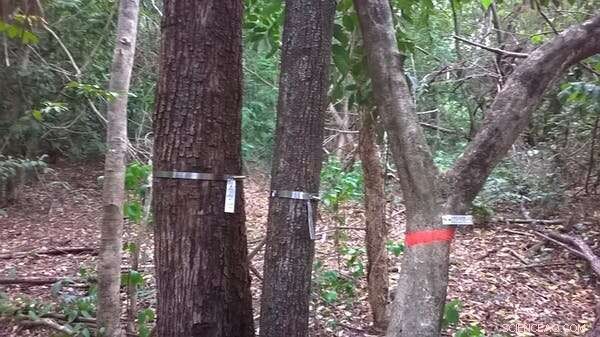
Dendrometer devices wrapped around tree trunks to measure growth. Auteur fourni
Carbon capture is just one ecosystem service in an incalculably long list. Biodiverse ecosystems provide a dizzying array of pharmaceutically active compounds that inspire the creation of new drugs. They provide food security in ways both direct (think of the millions of people whose main source of protein is wild fish) and indirect (for example, a large fraction of crops are pollinated by wild animals).
Natural ecosystems and the millions of species that inhabit them still inspire technological developments that revolutionize human society. Par exemple, take the polymerase chain reaction ("PCR") that allows crime labs to catch criminals and your local pharmacy to provide a COVID test. PCR is only possible because of a special protein synthesized by a humble bacteria that lives in hot springs.
As an ecologist, I worry that a simplistic perspective on the role of forests in climate mitigation will inadvertently lead to their decline. Many tree planting efforts focus on the number of saplings planted or their initial rate of growth—both of which are poor indicators of the forest's ultimate carbon storage capacity and even poorer metric of biodiversity. More importantly, viewing natural ecosystems as "climate solutions" gives the misleading impression that forests can function like an infinitely absorbent mop to clean up the ever increasing flood of human caused CO
Heureusement, many big organizations dedicated to forest expansion are incorporating ecosystem health and biodiversity into their metrics of success. A little over a year ago, I visited an enormous reforestation experiment on the Yucatán Peninsula in Mexico, operated by Plant-for-the-Planet—one of the world's largest tree planting organizations. After realizing the challenges inherent in large scale ecosystem restoration, Plant-for-the-Planet has initiated a series of experiments to understand how different interventions early in a forest's development might improve tree survival.
But that is not all. Led by Director of Science Leland Werden, researchers at the site will study how these same practices can jump-start the recovery of native biodiversity by providing the ideal environment for seeds to germinate and grow as the forest develops. These experiments will also help land managers decide when and where planting trees benefits the ecosystem and where forest regeneration can occur naturally.
Viewing forests as reservoirs for biodiversity, rather than simply storehouses of carbon, complicates decision making and may require shifts in policy. I am all too aware of these challenges. I have spent my entire adult life studying and thinking about the carbon cycle and I too sometimes can't see the forest for the trees. One morning several years ago, I was sitting on the rainforest floor in Costa Rica measuring CO
As I waited for the measurement to finish, I spotted a strawberry poison dart frog—a tiny, jewel-bright animal the size of my thumb—hopping up the trunk of a nearby tree. Intrigued, I watched her progress towards a small pool of water held in the leaves of a spiky plant, in which a few tadpoles idly swam. Once the frog reached this miniature aquarium, the tiny tadpoles (her children, as it turned out) vibrated excitedly, while their mother deposited unfertilised eggs for them to eat. As I later learned, frogs of this species (Oophaga pumilio) take very diligent care of their offspring and the mother's long journey would be repeated every day until the tadpoles developed into frogs.
It occurred to me, as I packed up my equipment to return to the lab, that thousands of such small dramas were playing out around me in parallel. Forests are so much more than just carbon stores. They are the unknowably complex green webs that bind together the fates of millions of known species, with millions more still waiting to be discovered. To survive and thrive in a future of dramatic global change, we will have to respect that tangled web and our place in it.
Cet article est republié à partir de The Conversation sous une licence Creative Commons. Lire l'article original. 